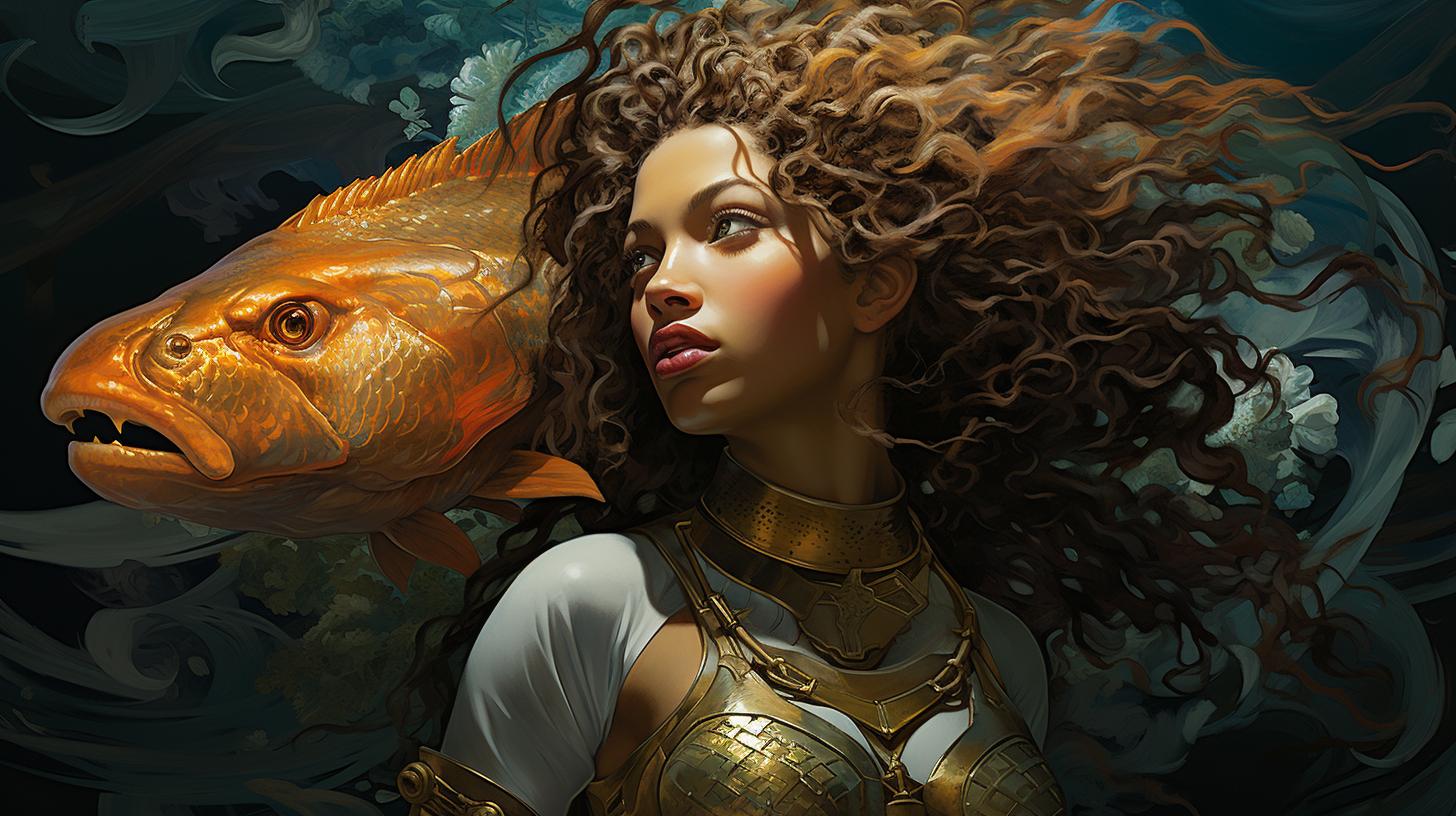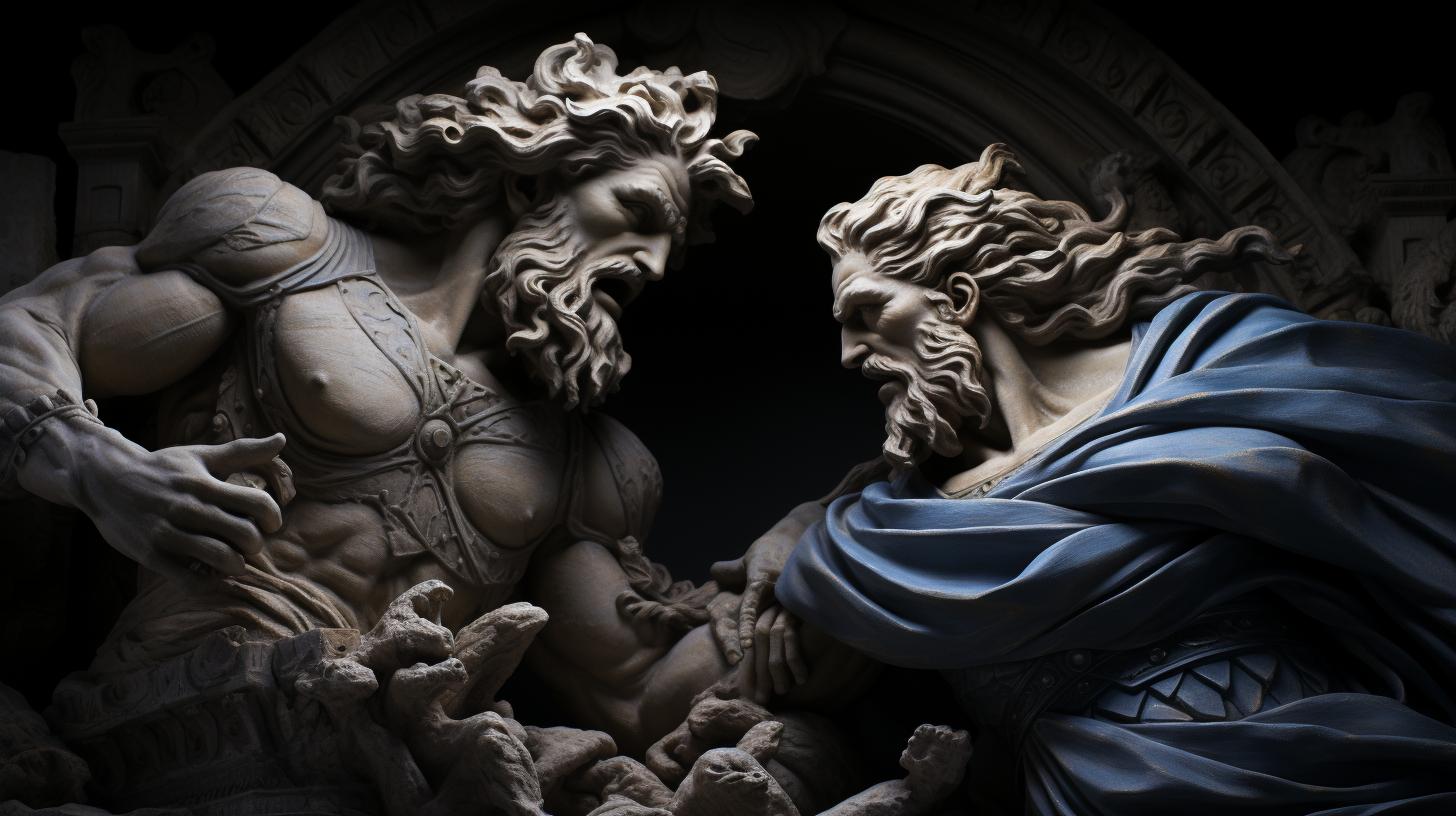Tethys Greek Mythology

Tethys, the Titan goddess of Greek mythology, holds an important place in ancient lore. As the daughter of Uranus and Gaia, she personified the vast oceans and freshwater sources.
Tethys, alongside her husband Oceanus, represented the ever-flowing waters that encompassed the world. Their influence extended over natural bodies of water, including rivers and springs. Although Tethys had minimal direct worship and representation, her role as a vital figure in the natural world cannot be overlooked.
This article delves into various aspects of Tethys’ mythology, from her family connections to her influence on Greek culture and beyond.
Tethys: The Titan Goddess of the Oceans
Tethys, a prominent figure in Greek mythology, was revered as one of the Titans and considered an ancestor to the mighty Olympian gods and goddesses. As the daughter of Uranus and Gaia, she held a significant position in the divine hierarchy.
Tethys was closely associated with the concept of the ocean and freshwater sources, embodying the essence of these life-giving elements.
Together with her spouse Oceanus, Tethys personified the vast and ever-flowing waters that encircled the world according to ancient Greek belief.
Their power and influence extended over the natural realm, particularly in relation to bodies of water. Tethys, as a Titanide, represented the expansive and invigorating masses of water, such as springs and rivers.
She played a crucial role in the cosmogony of ancient Greece, symbolizing the essential role of water in the natural world.
Married to Oceanus, the divine couple were regarded as deities associated with water.
While Oceanus was connected to a massive freshwater river believed to encircle the Earth, Tethys was closely associated with the freshwater sources that flowed into the world. Together, they gave birth to numerous offspring, including the Potamoi, gods of the rivers, and the Naiads, nymphs of moving waters.
Tethys’ identity as a grandmother was firmly established through her roles as a mother and grandmother.
Although Tethys did not receive direct worship and had relatively few representations in Greek mythology, she slowly became entwined and replaced by the goddess Thalassa, who served as a more general personification of the sea.
Nonetheless, Tethys remains a significant titan goddess in Greek mythology, embodying the principles of freshwater and flowing waters. Her influence on the natural world and her familial connections to other deities make her a captivating figure in ancient Greek lore.
Tethys and Oceanus: The Divine Couple
In the vast realm of Greek mythology, Tethys and Oceanus hold a significant position as the divine couple. As Titans, they played a vital role in shaping the natural world, particularly in their association with water.
Tethys, as the goddess of freshwater, and Oceanus, as the god of the great ocean, symbolized the eternal flow of waters that encircled the earth.
Their union represented the harmonious balance between the vast, ever-flowing waters and the life-giving freshwater sources. Tethys, with her role as the bringer of rivers and springs, complemented Oceanus, who encompassed the great saltwater bodies.
Together, they embodied the interconnectedness of different water forms and their essential role in sustaining life on Earth.
As divine entities, Tethys and Oceanus were revered and respected by the ancient Greeks. Their influence extended beyond the natural world and permeated various aspects of Greek culture and beliefs.
The abundance and fertility associated with the flow of waters symbolized by Tethys and Oceanus held deep significance in the agricultural and spiritual realms. Their presence was felt in rituals and ceremonies, where prayers were offered for plentiful harvests and the prosperous flow of rivers.
Tethys and Oceanus’s divine influence also manifested through their children, the Potamoi (river gods), and the Naiads (nymphs of the waters). These offspring were intricately connected to various bodies of water, adding richness and diversity to the realm that Tethys and Oceanus governed.
Throughout Greek mythology, Tethys and Oceanus represented the power and majesty of water in its many forms. Their divine union underscored the importance of balance and harmony between the vast seas and the freshwater sources that sustained life.
Their presence pervaded the mythological tapestry of ancient Greece, leaving an indelible mark on the collective imagination of the people.
Tethys as Mother: Offspring and Family Connections
Tethys, the Titan goddess of the oceans, played a significant role as a mother in Greek mythology. Her union with her husband Oceanus resulted in the birth of numerous offspring, who held important roles in the divine hierarchy.
One group of Tethys’ children were the Potamoi, the river gods. These were deities who presided over the various rivers flowing across the Earth. Each Potamoi had their own domain and was associated with a specific waterway.
These river gods were believed to bring fertility and nourishment to the lands they traversed, making them vital figures in both myth and the natural world.
In addition to the Potamoi, Tethys was also the mother of the Naiads, nymphs who symbolized the moving waters.
The Naiads were associated with fountains, springs, and other sources of freshwater, embodying the life-giving properties of these important natural features.
Tethys’ role as a mother extended beyond her direct offspring, as she was also a grandmother figure.
Through her children and grandchildren, she established familial connections that tied her to other deities and further emphasized her importance within the divine pantheon.
It’s worth noting that Tethys’ identity as a mother and grandmother was intertwined with her role as a goddess of water.
Just as water sustains and nurtures life, Tethys held a similar nurturing presence within the mythological realm.
As the goddess of freshwater and moving waters, Tethys left a lasting impact on Greek mythology.
Her lineage and relationships with other deities solidified her place in the divine family tree, while her association with rivers and nymphs emphasized the fundamental role of water in the natural world.
Tethys and the River Gods: Guardians of Freshwater
Tethys, the Titan goddess associated with water, played a significant role in Greek mythology as the mother of the river gods. These divine beings, known as Potamoi, were the personifications of various rivers flowing across the land.
Tethys’ connection to these river gods elevated her status as a guardian and nurturer of freshwater sources.
As a Titanide, Tethys represented the vast expanses of water, including springs and rivers.
She and her husband Oceanus were revered as powerful deities with influence over the natural world, particularly bodies of water. Tethys’ role as a mother extended beyond her own offspring to encompass the river gods, who were considered her grandchildren.
- The river gods held distinct identities and presided over specific rivers, each with unique characteristics and associations.
- The Potamoi were both mighty and gentle, sometimes depicted as bearded men and other times as youthful figures.
They embodied the captivating beauty and strength of rivers.
- Tethys’ connection to the river gods emphasized her role as a protector of their domains and a source of life-giving water.
- Together, Tethys and the river gods sustained the delicate balance of freshwater ecosystems, ensuring the fertility and vitality of the land.
In Greek mythology, rivers were not merely geographical features but had their own divine personalities.
The river gods, under the watchful eye of Tethys, influenced the lives of mortals, offering blessings and fertility to nearby lands. They were worshipped and held in high regard by local communities who relied on these rivers for sustenance and prosperity.
Through the association of Tethys with the river gods, Greek mythology acknowledged the vital role of freshwater sources in the natural world. It recognized the interconnectedness of water and life, with Tethys embodying the essence of these ever-flowing rivers and their crucial significance to both humans and nature.
Tethys in Homer’s Iliad: References and Interpretations
Tethys, the Titan goddess of the oceans, finds her presence subtly woven into the fabric of Homer’s epic poem, the Iliad. While she may not be a central character, her influence can be seen through references and interpretations.
In the Iliad, Tethys serves as a symbol of the underlying power and vastness of the sea. She represents the ever-flowing waters that hold an immense force, shaping the destiny of the world and its heroes.
Though not explicitly mentioned by name, her essence can be seen in the portrayal of the sea as a formidable and unpredictable force.
Furthermore, Tethys’ association with the ocean reflects the dichotomy between chaos and order depicted in the Iliad.
The sea, like the emotions and desires of the characters, is often tumultuous and uncontrollable. Tethys symbolizes the primordial energy that lurks beneath the surface, impacting both mortal and divine actions.
Interpretations of Tethys in the Iliad vary among scholars. Some view her as a representative of the natural world, reminding readers of the ever-present power of the elements. Others see her as a metaphor for the matriarchal forces that influence the course of events, shaping the destinies of gods and mortals alike.
While her direct role in the Iliad may be limited, Tethys’ presence leaves a lasting impression. Her association with the untamed seas adds depth and complexity to the narrative, reminding readers of the larger forces at play in the world of the epic poem.
Tethys in Hesiod’s Theogony: Role and Significance
In Hesiod’s Theogony, Tethys plays a significant role in the genealogy and hierarchy of the Greek gods and goddesses. She is introduced as a Titanide, daughter of Uranus (the sky) and Gaia (the earth), and sister of the Titans.
Tethys’ role in Theogony is primarily focused on her familial connections and her influence on the natural world.
As a Titanide, Tethys represents the vast and vitalizing bodies of water, such as springs and rivers.
Her association with water highlights its essential role in the natural order of the world. According to Theogony, Tethys is married to her brother, Oceanus, and together, they personify the eternal and flowing waters that encircle the earth.
Tethys and Oceanus have numerous children, including the Potamoi, who are the gods of rivers, and the Naiads, nymphs of moving waters. These offspring further emphasize Tethys’ connection to freshwater and demonstrate her role as a maternal figure in Greek mythology.
In Hesiod’s Theogony, Tethys’ significance extends beyond her immediate family. She represents the bond between the earth (Gaia) and the waters. This connection reinforces the fundamental relationship between water and the natural world in Greek cosmology.
While Tethys herself is not extensively discussed in Theogony, her presence creates a framework for understanding the hierarchy of the gods and the importance of water in Greek mythology. Her role as a central figure in the genealogy of the gods highlights the significance of water as a life-giving and vital element.
Tethys in Greek Mythology’s Pantheon: Connections and Influences
Tethys, as one of the Titans in Greek mythology, held a significant position in the pantheon of deities. Her connections and influences within the mythology are fascinating, shedding light on her importance and interactions with other gods and goddesses.
Amongst Tethys’ notable connections is her relationship with her sister, Gaia, who personified the Earth. As siblings and daughters of Uranus, the primal god of the sky, they shared a deep bond and played essential roles in the creation of the world.
Tethys’ association with water harmoniously intertwined with Gaia’s connection to land, symbolizing the interdependence of these fundamental elements.
Additionally, Tethys’ allegiance to her husband, Oceanus, further emphasized her role within the Greek pantheon.
Oceanus represented the encompassing fresh-water stream believed to encircle the Earth, while Tethys embodied the flowing freshwater sources that fed into the world. Together, they personified the vastness of water and its life-giving properties.
The influence of Tethys extended beyond her immediate family. Tethys was the mother of numerous gods and nymphs, including the Potamoi, the river gods, and the Naiads, nymphs associated with flowing waters.
Through her maternal role, Tethys contributed to the divine lineage and played a crucial part in shaping the natural world. The rivers became her divine progeny, nurturing the landscapes and sustaining life.
Moreover, Tethys’ significance is apparent in various Greek literary works. In Homer’s Iliad, Tethys is mentioned several times, highlighting her revered status among the gods. Her name is invoked alongside other deities as a demonstration of her power and influence.
In Hesiod’s Theogony, a poem that narrates the genealogy of the gods, Tethys plays a vital role in the cosmogony. She represents the elemental force of water and its indispensable role in the creation and sustenance of the world.
Throughout Greek mythological pantheon, Tethys’ connections and influences can be observed. She is often referenced in philosophical dialogues, depicted in art, and serves as a central figure in the ancient Greek concept of the cosmos.
Her connection to water, her divine offspring, and her role as a nurturing mother figure contribute to her everlasting presence within Greek mythology.
Tethys in Roman Mythology: Adaptation and Transformation
In Roman mythology, Tethys underwent certain adaptations and transformations while maintaining her association with water.
The Romans identified her closely with the goddess Salacia, who was considered the wife of Neptune, the god of the sea. This assimilation merged the Greek concept of Tethys as a Titaness of freshwater with the Roman perception of Salacia as a deity of the salty sea.
Salacia, like Tethys, was revered as a powerful goddess with dominion over the waters. She was believed to control the ebb and flow of the tides and had the ability to calm or stir the sea according to her will.
This connection between Tethys and Salacia further solidified Tethys’ role as a significant figure in Roman mythology.
Throughout Roman culture, Tethys’ representation expanded to encompass various aspects of water, including rivers and springs.
She became associated with the nurturing and life-giving qualities of freshwater, reflecting the Romans’ reverence for the essential role of water in agriculture and daily life.
In Roman art and iconography, Tethys was often depicted in regal attire, holding a horn of plenty overflowing with water.
This imagery reinforced her position as a fertility goddess and a provider of abundance. Roman poets and writers also invoked Tethys in their works, emphasizing her connection to the natural world and her association with the divine.
Overall, Tethys’ incorporation into Roman mythology allowed her divine essence to adapt and transform, aligning her with the Romans’ own beliefs and customs surrounding water and its significance in their culture.
Tethys vs. Thalassa: Confusion and Replacement in Mythology
In Greek mythology, the distinction between Tethys and Thalassa, two goddesses associated with the sea, can be a subject of confusion and debate. While Tethys was primarily linked to freshwater sources like rivers and springs, Thalassa represented the vast expanse of the sea itself.
Over time, their roles became intertwined, leading to a blending of their identities.
Thalassa, meaning “sea” in Greek, gradually emerged as a more general embodiment of the ocean, overshadowing Tethys in certain aspects.
This shift resulted in Tethys being increasingly marginalized and even replaced by Thalassa in some mythological narratives. The reasons behind this substitution range from regional variations to the evolving cultural interpretations of the sea.
One potential explanation for the replacement of Tethys by Thalassa lies in the geographical influence. Tethys was more commonly worshipped in regions with a significant focus on freshwater sources, such as rivers and springs.
On the other hand, Thalassa gained prominence in coastal communities heavily influenced by maritime activities. As societies expanded their interactions with the sea, Thalassa’s significance grew, partially overshadowing Tethys’ role.
The replacement of Tethys by Thalassa can also be attributed to a broader trend in Greek mythology.
Over time, certain deities underwent assimilation or absorption by others, resulting in a consolidation of their attributes and functions. Thalassa’s emergence as a more comprehensive representation of the sea led to a gradual erosion of Tethys’ distinct role as the goddess of freshwater sources.
Despite this replacement and confusion, Tethys still retained a significant presence within the mythology. Some ancient texts mention Tethys alongside Thalassa, highlighting the existence of both goddesses in different contexts. This coexistence suggests that even as Thalassa gained prominence, Tethys continued to be recognized, albeit to a lesser extent.
The confusion surrounding Tethys and Thalassa in Greek mythology underscores the complexities of interpreting ancient texts and the fluidity of divine roles over time. It serves as a reminder of how mythological narratives evolve and adapt to changing cultural and societal landscapes, sometimes resulting in the modification or replacement of deities.
Tethys and the Oceanids: The Nymphs of the Sea
One of the fascinating aspects of Tethys’ mythology is her connection to the Oceanids, who were the nymphs of the sea. These divine beings were born from Tethys and Oceanus, embodying the essence and spirit of the world’s vast oceans.
The Oceanids played a significant role in Greek mythology, appearing in various stories and serving as attendants to other prominent sea deities. They were known for their beauty, grace, and intimate knowledge of the sea’s mysteries.
- Amphitrite: The most famous Oceanid, she became the wife of Poseidon, the god of the sea. Together, they ruled over the ocean and had numerous sea god children.
- Clymene: She was the mother of Atlas, who famously held the heavens on his shoulders.
- Doris: She was the mother of the fifty Nereids, who personified different aspects of the sea, including waves, fish, and sea nymphs.
- Thetis: Perhaps the most renowned Oceanid, she was the mother of Achilles, the legendary hero of the Trojan War.
The Oceanids were often depicted as beautiful maidens, adorning the artwork and poetry of ancient Greece.
They symbolized the ever-changing and enigmatic nature of the sea, capturing the imaginations of many.
These nymphs played an essential role in the mythology and tales surrounding Tethys, representing the abundance, power, and beauty of the sea.
Tethys and Gaia: The Bond of Mother Earth and Water
Tethys, as one of the Titans in Greek mythology, held a unique connection with Gaia, the personification of Mother Earth. Together, Tethys and Gaia formed a powerful bond that represented the inseparable relationship between water and land.
This bond was crucial in maintaining the balance and harmony of the natural world.
As the daughter of Gaia, Tethys inherited her mother’s essence and became an embodiment of the life-giving waters that flowed through the Earth.
She nourished the rivers and springs, ensuring the continuous cycle of life and fertility. Tethys’ presence was felt in every drop of rain and every ripple in a pond, reflecting the interconnectedness of the earth and water elements.
Gaia, on the other hand, relied on Tethys’ waters to sustain her creations. The rivers and streams fed the plants and animals that inhabited the land, supporting the diverse ecosystems that Gaia had birthed.
Without Tethys’ influence, the earth would become barren and lifeless, emphasizing the symbiotic relationship between land and water.
This bond between Tethys and Gaia was not merely physical but also spiritual.
Tethys, as the embodiment of freshwater, carried the divine essence of Gaia within her. Their connection transcended the physical realm, symbolizing the eternal cycle of birth, growth, and renewal. Their unity represented the continuous flow of energy and vitality throughout the natural world.
- Tethys and Gaia’s bond highlighted the importance of the Earth’s water cycle.
- They exemplified the interdependence of land and water ecosystems.
- Their connection represented the life-giving properties of freshwater.
- Through Tethys, Gaia’s nurturing essence was carried and distributed.
As we delve into the mythology of Tethys and Gaia, it becomes evident that their bond was both sacred and vital.
Without Tethys’ waters, Gaia’s creations would cease to exist, and without Gaia’s land, Tethys’ waters would have no purpose. Together, they reminded ancient Greeks of the intricate balance required to sustain life on Earth.
Tethys and Uranus: Ancestral Lineage and Kinship
In Greek mythology, Tethys holds a significant place in the ancestral lineage as one of the Titans, the powerful beings preceding the Olympian gods and goddesses. Born as the daughter of Uranus (the sky) and Gaia (the earth), Tethys represents the connection between water and the overarching cosmic order.
As the personification of freshwater, Tethys shares a complex kinship with Uranus, her father. Alongside her husband Oceanus, she embodies the eternal flowing waters that surround and sustain the world.
This lineage establishes Tethys as a vital figure within the Greek mythological framework.
Uranus and Gaia birthed many Titans, including Cronus and Rhea, who later became the parents of Zeus and Hera, among others.
This intricate familial network highlights Tethys’ role as both mother and grandmother figure within the mythology.
The relationship between Tethys and Uranus symbolizes the bond between the sky and the waters, representing the fundamental forces that shape the natural world.
It emphasizes the interconnectedness of elements and the essential role of water in sustaining life. Their union embodies the cosmic harmony envisioned by the ancient Greeks, where each deity played a crucial part in the balance of the universe.
Although Tethys’ direct cult and representations are limited, her significance in Greek mythology resides in her ancestral lineage and kinship with Uranus. As a Titan goddess associated with waters and their life-giving properties, she exemplifies the essential connection between water, nature, and the wider realm of divine beings.
Tethys in Plato’s Dialogues: Philosophical Concepts and Allegories
In Plato’s dialogues, Tethys is often mentioned as part of philosophical discussions and allegorical representations. Plato, the renowned Greek philosopher, frequently employed mythological figures to convey his philosophical concepts and ideas.
One notable instance is found in Plato’s dialogue “Phaedrus,” where Tethys is mentioned in relation to the soul’s journey and the forms of beauty. Tethys symbolizes the depths of the subconscious, representing the vast realm of emotions and desires that shape human existence.
Plato uses Tethys as a metaphorical representation of the hidden aspects within ourselves that influence our perception and understanding of the world. Just as Tethys embodied the mysterious depths of the ocean, Plato suggests that our subconscious plays a significant role in shaping our thoughts, actions, and philosophies.
Another dialogue that references Tethys is “Timaeus,” in which Plato explores the creation of the universe. Tethys is associated with the concept of primordial water and its transformative power. Plato portrays Tethys as the source of life-giving waters, essential for the creation and preservation of all living beings.
Through these dialogues, Plato utilizes Tethys as a symbolic representation of profound philosophical concepts, such as the subconscious mind and the elemental forces that underpin existence. By drawing upon the rich mythology of Tethys, Plato enriches his philosophical arguments and invites readers to ponder the deeper meanings behind the surface narratives.
Tethys and Hera: Rivalry and Interactions with Other Deities
Tethys, the titan goddess of the Oceans, had an intricate relationship with Hera, the queen of the gods and the goddess of marriage and childbirth. Their interactions were often marked by rivalry and conflicts, as both goddesses held significant positions in Greek mythology.
Hera, being the wife of Zeus, the king of the gods, held a prominent role in the divine hierarchy. She was known for her jealousy and fierce protectiveness over her marriage, which often brought her into opposition with Zeus and his other consorts, including Tethys.
As the goddess of marriage and childbirth, Hera despised Zeus’ extramarital relationships, including his involvement with Tethys. This rivalry resulted in confrontations and animosity between the two goddesses.
Tethys, on the other hand, played a vital role in the natural world as the personification of the ocean and freshwater sources.
Despite her essential position, she often found herself entangled in the conflicts of the Olympian gods and goddesses, including Hera.
Although their rivalry was palpable, Tethys and Hera were not always at odds.
In some myths, they were depicted as working together, especially in instances where their interests aligned, such as protecting their children or intervening in matters related to the natural world.
While Tethys represented the vast bodies of water and their nurturing properties, Hera governed over the institution of marriage and the order of society.
Their contrasting domains often led to clashes, as each goddess sought supremacy within their respective realms.
It is worth noting that while Tethys did not receive as much attention and worship as Hera, her role in Greek mythology is undeniably significant.
Her interactions with Hera and other deities offer a glimpse into the intricacies of the divine hierarchy and the complexities of the Greek pantheon.
In summary, the relationship between Tethys and Hera in Greek mythology was characterized by rivalry and conflicts, rooted in their differing domains and positions within the divine hierarchy.
Despite their differences, there were instances where the two goddesses worked together, aligning their interests and exerting their influences in the world of gods and mortals.
Among the many significant interactions in Greek mythology, the encounters between Tethys and Zeus stand out as a fascinating display of power dynamics.
Zeus, the king of the gods, held great authority and influence, while Tethys, as a Titan goddess, commanded respect as a primordial deity associated with water.
In these mythological encounters, Zeus often sought the assistance or guidance of Tethys due to her deep understanding of the natural world and her connection to water sources.
Tethys, being the personification of freshwater, played a crucial role in the preservation and balance of the Earth. Her wisdom and knowledge were invaluable to Zeus, and he would turn to her for advice in various situations.
However, it’s important to note that Tethys was not subservient to Zeus. She held her own power and authority, often serving as a voice of reason, reminding Zeus of the consequences of his actions.
Their interactions highlighted the intricate dynamics between gods and Titans, showcasing mutual respect and a delicate balance of power.
While Tethys and Zeus primarily collaborated on matters concerning the natural world, their encounters also unfolded within the context of broader mythological narratives. These stories explored themes of divine hierarchy and the interplay between gods and Titans, shedding light on the complexities of Greek mythology.
Tethys in the Homeric Hymns: Homage and Praises to the Goddess
In the Homeric Hymns, Tethys, the Titan goddess of the oceans, receives great admiration and reverence. She is praised for her role as the personification of water and her vital presence in the natural world.
The hymns depict Tethys as a powerful deity, embodying the essence of life-giving and purifying waters.
These hymns pay homage to Tethys by highlighting her significance within the Greek pantheon.
They acknowledge her as the mother of rivers, springs, and nymphs, emphasizing her connection to the entire water cycle. Tethys’ influence over freshwater sources and the abundance they bring is celebrated in the hymns through poetic verses and heartfelt praises.
- The Life-Giving Waters: The Homeric Hymns describe Tethys as the source of all nourishing waters on Earth. She is revered for her ability to sustain and vitalize the natural world with her flowing streams and fountains.
Tethys’ life-giving waters are seen as essential for the growth and prosperity of plants, animals, and humans alike.
- Purification and Cleansing: Tethys is also praised for her purifying and cleansing powers.
She is believed to cleanse both the physical and spiritual impurities, providing a sense of renewal and purification. The hymns express gratitude for Tethys’ ability to restore purity and bring harmony to the world.
- Interactions with Other Deities: The Homeric Hymns depict Tethys’ interactions and collaborations with other gods and goddesses.
She is often portrayed as an ally to Zeus, Hera, and other Olympian deities. The hymns emphasize Tethys’ role in maintaining balance and supporting the harmony within the divine hierarchy.
The Homeric Hymns serve as a testament to the significance of Tethys in Greek mythology.
They reflect the deep respect and admiration the ancient Greeks held for Tethys and her role as a vital force in the natural world. Through poetic verses and heartfelt praises, these hymns ensure that Tethys’ contribution to the divine tapestry is celebrated and remembered.
Tethys as a Central Figure: Depictions and Representations in Art
Tethys, the Titan goddess of the oceans, has been a central figure in various artistic works throughout history. Artists have sought to capture her essence and significance in their depictions, showcasing her role as a powerful deity associated with freshwater and the natural world.
One prevalent theme in Tethys’ artistic representations is her connection with water. Artists often depict her surrounded by flowing rivers, cascading waterfalls, or serene lakes, emphasizing her dominion over these vital bodies of water.
Her serene and regal demeanor is often portrayed, reflecting her divine and motherly role within Greek mythology.
- Water Symbolism: Artists utilize various symbols to represent Tethys’ association with water.
Waves, seashells, and aquatic creatures are commonly incorporated into her imagery, representing the vastness and abundance of the oceans under her control.
- Flowing Robes: Tethys is often depicted wearing flowing robes that mimic the fluidity of water, enhancing her role as the personification of freshwater.
These garments cascade elegantly, further emphasizing her connection to the ever-flowing nature of rivers and springs.
- Divine Consort: In some artistic depictions, Tethys is shown alongside her husband Oceanus, solidifying their inseparable bond as deities of the waters.
Their union represents the harmonious interplay between freshwater and saltwater, highlighting the interconnectedness of all bodies of water.
- Maternal Symbolism: As a motherly figure, Tethys is sometimes portrayed with her divine offspring, the Potamoi (river gods) and the Naiads (water nymphs).
These depictions showcase the nurturing aspect of her character and emphasize her profound influence over the natural world’s water sources.
Throughout the centuries, Tethys’ representations in art have evolved, adapting to different artistic styles and interpretations.
This adaptability showcases her enduring significance and the enduring fascination artists have with her mythological role.
Tethys and the Greek Mythology Timeline: From Creation to Titans’ Reign
Tethys is an integral part of the Greek mythology timeline, representing the primordial times and the reign of the Titans. As a Titan goddess, she played a significant role in the creation of the world as understood by the ancient Greeks.
The timeline begins with the mythological account of the creation of the universe. According to Greek mythology, Tethys was the daughter of Uranus (the sky) and Gaia (the earth).
She, along with her siblings, the Titans, preceded the famous Olympian gods and goddesses.
During the early stages of the mythological timeline, Tethys and her husband Oceanus personified the vast and eternal waters that enveloped the world.
They were revered as powerful deities whose influence extended over the natural world, particularly bodies of water.
Tethys and Oceanus held sway over not only the saltwater oceans but also freshwater sources, such as springs and rivers.
Their progeny included the Potamoi, gods of the rivers, and the Naiads, nymphs of moving waters.
As the mythological timeline progresses, Tethys and the Titans face a challenge from the next generation of gods, the Olympians.
A great Titanomachy, or war between the Titans and the Olympians, ensued. The Titans, including Tethys, ultimately lost the battle and were banished, replaced by the Olympian gods and goddesses.
Through Tethys’ role in the Greek mythology timeline, we gain insights into the early cosmogony and the transition from the reign of the Titans to the dominance of the Olympian gods and goddesses.
Her significance lies in representing the essential role of water in the natural world and the mythological progression.
Tethys in Popular Culture: Influence and References in Modern Media
Tethys, the Titan goddess of Greek mythology, continues to have a significant influence in popular culture and can be found referenced in various forms of modern media. From literature to films and even video games, Tethys’ presence emerges, demonstrating the enduring impact of Greek mythology.
Literature
- Many contemporary authors draw inspiration from Greek mythology, with Tethys often making appearances in their works. She is portrayed as a powerful deity, representing the vastness and mysteries of the ocean.
- Novels, such as fantasy and historical fiction genres, often incorporate Tethys as a character or as part of the world-building elements.
- Her role as a mother figure and her connection to water symbolize both nurturing and formidable aspects, adding depth to the narratives.
Film and Television
- Tethys’ allure can also be seen on the big screen, with movies featuring her as a central character or as part of the Greek mythology ensemble.
- From epic adventures to animated films, Tethys continues to captivate audiences with her association with water and her mythical origins.
- Television series often depict Tethys in various ways, showcasing her influence in shaping the natural world and impacting the lives of other deities.
Video Games
- Tethys and her association with water play vital roles in many video game narratives, especially those incorporating Greek mythology elements.
- Players may encounter Tethys as a boss character, interact with her as a deity providing quests, or explore underwater realms inspired by her domain.
- Her presence in video games adds a sense of mysticism and ancient power to the immersive gaming experience.
Tethys, as a figure from Greek mythology, persists in modern media, captivating audiences and leaving a lasting impression.
Whether through literature, film and television, or video games, her influence continues to be an intriguing aspect of popular culture, keeping the legacy of ancient Greek mythology alive and vibrant.
.




















